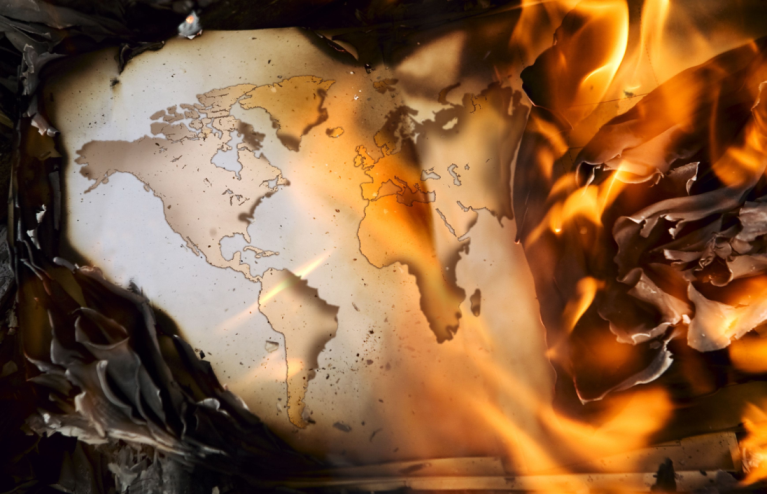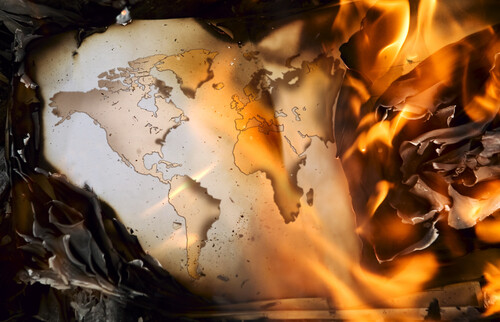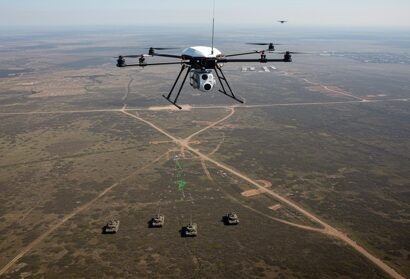Abstract: Amid the ongoing global crisis, the Middle East is once again becoming the chessboard of critical military dynamics. Iran has presented a primary foreign policy challenge for the United States since the Islamic Revolution in 1979. Over the last decades, the U.S. and Israel have engaged in a hybrid war with Iran and its regional proxies. While Europe has preferred to impose sanctions on individuals and units inside the country instead of blacklisting the Iranian elite force, fearing repercussions and still hoping to revive the JCPOA, the U.S./Israel strategy, by contrast, seems to move towards a military confrontation. Indeed, Israel, which was previously placed in the European Command (EUCOM) Area of Responsibility due to tensions with neighbouring Arab countries, was shifted to the U.S.’ Central Command (CENTCOM) Area of Responsibility, underlining not only Tel Aviv’s improved ties with several regional leading actors, but also an alignment in their foreign policy towards Iran. Recent visits demonstrate that Iraq became a critical part of U.S./Israel countermeasures to reduce Iranian influence in the Middle East.
Problem statement: Might Iraq again become the epicentre of a Middle Eastern crisis arising from a direct military confrontation between the U.S./Israel bloc and the Islamic Republic of Iran?
Bottom-line-up-front: Recent U.S.-Israel joint military drills suggests the states might be ready to confront Iran directly. Iraq seems to be the epicentre of the ongoing confrontation; the country and its Shia community have historical ties with Tehran. However, since the U.S. invasion in 2003, Washington has gained significant leverage. Europe’s energy needs put gas-reach Iraq on the agenda of Western actors.
So what?: If the U.S. and Israel want to confront Iran, they should enhance ties with both Iraqi governments in Baghdad and Erbil, and avoid policies that lead to the destabilisation of the Middle East. Iran should exploit its religious and political leverage on the Iraqi Shia community and proxies to counter the U.S./Israel strategy.

Source: shutterstock.com/Ulza
A Destabilised Middle East
Amid the ongoing global geopolitical crisis, characterised by NATO’s confrontation with Russia, China and Iran, the Middle East is becoming once again the chessboard of critical dynamics and the battlefield of regional and international superpowers. While in August 2022, European leaders were sure to achieve a new nuclear deal with Tehran’s leadership, regional tensions with Israel and ongoing widespread Iranian protests cast a shadow over the agreement pushing the United States and the Islamic Republic of Iran to revive historical rivalries.
Amid the ongoing global geopolitical crisis, characterised by NATO’s confrontation with Russia, China and Iran, the Middle East is becoming once again the chessboard of critical dynamics and the battlefield of regional and international superpowers.
U.S./Israel Unconventional Warfare With Iran in the Middle East
Under the Biden administration, the Department of Defence wanted to economise on U.S. force deployments to the United States Central Command (CENTCOM) area of responsibility (AOR) where possible. Consequently, the world experienced the withdrawal of U.S. troops from Afghanistan in August 2021 without leaving a residual force, and Iraq, starting from September 2021, maintained an advisory presence. The decision to withdraw from Afghanistan was instrumental in permitting the U.S. Defence Department to have a more significant number of U.S. forces available for potential deployments to counter threats from the People’s Republic of China or Russia.
In addition, the U.S. foreign strategy shift towards the Indo-Pacific led the mainstream to perceive Washington disengaged from the Middle East. This narrative was rebutted by Under Secretary of Defence for Policy Colin Kahl’s stances, according to whom the United States remains committed to the region. “We haven’t gone anywhere,” stated Kahl.[1]
Beyond the official stances, Israel and the U.S. undeniably have been engaged in a hybrid conflict with Iran in the Middle East for decades. While Washington’s most significant recent achievement was the killing of the leader of the Islamic Revolutionary Guard Corps (IRGC) Quds Force, Qassem Soleimani, under the Trump administration, Israel has targeted several Iranian nuclear scientists within Iran, damaged the Natanz nuclear site engaging in cyberwarfare with Tehran, and destroyed multiple weapons storages of Hezbollah in Syria.
U.S. policy towards Iran also includes sanctions, providing aid and arms to partners, and two maritime missions in the Persian Gulf: the Combined Maritime Forces (CMF), a 34-nation coalition focused on defeating terrorism and preventing piracy, and the International Maritime Security Construct (IMSC), a ten-member coalition focused on maritime shipping lanes, providing surveillance and patrolling in the Strait of Hormuz and the Bab el Mandeb.[2]
Indeed, Iran has staged a series of attacks on shipping in the region over the past years, including limpet mine attacks that damaged tankers. According to the maritime intelligence firm Dryad Global, the seizure of vessels is the Iranian response to outside pressures, economic conflicts and other perceived grievances. Tehran targets vessels directly connected with ongoing disputes and vessels operating within the ‘grey space’ of legitimacy, which may be involved in illicit trade.[3]
Iran has staged a series of attacks on shipping in the region over the past years, including limpet mine attacks that damaged tankers. According to the maritime intelligence firm Dryad Global, the seizure of vessels is the Iranian response to outside pressures, economic conflicts and other perceived grievances.
A critical and increasingly common practice for Iran is the capture of unmanned U.S. sea drones, not simply to destroy them but also to attempt to reverse-engineer the technology. Although the U.S. has imposed strict export control restrictions and sanctions to prevent Iran from obtaining high-end materials, a remarkable amount of US-made components, many of them manufactured in the last couple of years, have been found in the Iranian drones deployed across Ukraine.[4]
Iraq’s Role In The New U.S./Israel – Iran Confrontation
Iraq finds itself again at the dynamics’ epicentre of the Middle East. The country has not yet recovered from the 2003 U.S. invasion and has experienced a protracted governance crisis due to internal rifts. Historically, Iran has heavily influenced the Shia-majority country; Khomeini spent part of his exile in Iraq, and vice versa, several politicians and militia leaders from Iraq spent years in exile in Tehran during Saddam Hussein’s regime.
While the invasion of Iran by Western-backed Iraq signalled a fracture in the relations between Tehran and Baghdad, the Iran-Iraq war (1980-1988) also offered a unique training ground for the newly established Iranian Islamic military bodies (Iranian Revolutionary Guard Corp – IRGC, Quds Force, Basij). Although it was unintended, by overthrowing Saddam Hussein, the U.S. supplied the key linkage for forming a Shia Muslim bloc in the Middle East. Reinforced by the joint fight against ISIS, Shia militias backed by Tehran gained power in most Middle Eastern countries, forming the Axis of Resistance.[5] The Iraqi Shia armed groups (legalised by Iraqi Parliament in 2016) merged under the umbrella of the Popular Mobilisation Forces after a religious decree (fatwa) issued by Gran Ayatollah Ali Sistani following the collapse of the Iraqi Military in 2014 due to the rise of the Islamic State.[6]
As for Washington, since 2015, the U.S. Department of State provided Iraq with 1.25 billion dollars in Foreign Military Financing (FMF) to improve Iraq’s long-term sustainment and logistics capabilities and cooperated with the Iraqi Security Forces (ISF), including the Peshmerga forces. While remarkably the U.S. still remains a fundamental partner in the fight against religious extremism, through its militias, Tehran gained military and political ground in Iraq. The increasing involvement of Iran in Iraq’s dynamics concerned the U.S. government, which is renewing its focus both on Baghdad and Erbil.[7]
Since 2015, the U.S. Department of State provided Iraq with 1.25 billion dollars in Foreign Military Financing to improve Iraq’s long-term sustainment and logistics capabilities and cooperated with the Iraqi Security Forces, including the Peshmerga forces.
The Iranian government’s crackdown on protests and Tehran’s weapons delivery to Russians in Ukraine, which the Iranian Foreign Minister has repeatedly denied, were also of significant concern to the U.S. It should be noted that Amir Abdollahian replied to Western allegations that Iran and Russia indeed have an agreement on weapons exchange. However, the agreement was signed before Moscow started the so-called ‘special military operation’.[8]
In recent months, the United States’ countermeasures to stamp out money laundering and the channelling of dollars to Iran and Syria from Iraq have severely restricted Iraq’s access to hard currency. Since the U.S. invasion of Iraq in 2003, Iraq’s foreign currency reserves have been housed at the United States Federal Reserve, giving Washington significant control over Iraq’s supply of dollars.
As for Israel, for several years, it has sought a regional strategy based on enhancing ties with territorial entities along the Iranian borders, a strategic move developing capabilities for a direct attack on Iran if needed. Tel Aviv pursued closer cooperation with Baku, arming Azerbaijan during the war with Armenians over Artsakh/Nagorno-Karabakh territories and signing multiple agreements in the military field.[9] Simultaneously, Israel has cultivated its interests in Iraqi Kurdistan, trying to exploit a closer relationship with Erbil to counter Tehran’s influence. Israel’s Prime Minister Benjamin Netanyahu recently declared his support for Iraqi Kurds’ independence.
In 2015, Washington was assessing how to hamper the Islamic State of Iraq and the Levant’s (ISIL) ability to generate revenue and use its energy control to dominate areas under its rule. Although nowadays, the target is no longer the Islamic State, to counter Iran’s influence, still the U.S. strategy seems to be similar to the one that Washington exploited to fight ISIL. In 2015, former U.S. Special Envoy and Coordinator for International Energy Affairs Amos Hochstein stated that Turkey was at a “critical crossroads,” both for its energy supply and its ability to support Europe’s goal of energy security, adding that there was no reason why Iraqi Kurdish gas could not flow through Turkey into Europe. By contrast, today, Washington seems to be trying to convince Erbil and Baghdad to cut energy cooperation with Iran and supply its gas to Europe.[10] This confirmed that Turkey is becoming a strategic Eurasian energy hub for Brussels and that the U.S. is trying to isolate Iran from its Iraqi partners. Several recent visits suggest that Washington’s strategy is to interrupt energy cooperation between Iran and Iraq as it did with the Islamic State in order to reduce Tehran’s incomes: on January 18th, 2023, Brett McGurk, President Biden’s top Middle East adviser and Amos Hochstein, which currently is the State Department energy envoy, visited Iraq and discussed, among other topics, the need to ease tensions between the regional and federal governments over oil production in the area. Twice after the visit, the Prime Minister of the Kurdistan Region, Masrour Barzani, emphasised the importance of more American trade and investment in the Kurdistan Region and Iraq. Finally, they visited Israel.[11]
Today, Washington seems to be trying to convince Erbil and Baghdad to cut energy cooperation with Iran and supply its gas to Europe.
Allegedly, the U.S. blamed the Iraqi Kurdistan leadership for having not resolved internal friction between the Kurdistan Democratic Party (KDP) and the Patriotic Union of Kurdistan (PUK), the two main parties ruling the Iraqi Kurdish region, which has favoured the spread of Iranian influence.[12] The KDP, which controls the Kurdish government in Erbil, and the PUK, which dominates areas along the Iranian border and is headquartered in Sulaimaniya, have already experienced a conflict (1994-1998).[13] To realise Washington’s plan to supply Europe with Iraqi gas via Turkey, the Kurdistan region should avoid conflicts. Baghdad and Erbil have to overcome the legal dispute over the Kurdish regional administration’s oil and gas law, which Iraq’s federal supreme court last year deemed as “unconstitutional.”[14] Washington pressured the two governments to resolve the issue, given the need to stabilise the region in case of a confrontation with Iran.[15]
The U.S. failed to consider Turkey’s role in the north of Iraqi. Ankara has established new military bases on Iraqi soil in the past years, and incursions and shellings forced residents to flee. Officially, the military operations’ goal is combating Kurdish insurgency, but as an outcome, Ankara is gaining control over vital Middle Eastern territories.[16] While the Turkish presence might serve the strategy of supplying Iraqi gas to Europe by stabilising the area, Ankara might not be willing to reduce its territorial gains. Therefore, Turkey and the U.S.’s goals might not align in Iraqi Kurdistan.
The U.S. failed to consider Turkey’s role in the north of Iraqi. Ankara has established new military bases on Iraqi soil in the past years, and incursions and shellings forced residents to flee.
As for Iran, Tehran accused Iranian Kurdish groups based in Iraqi Kurdistan of cooperating with Israel multiple times. Notably, Tehran blamed the Kurdish counterrevolutionary and Tel Aviv for the recent attack on the defence ministry facility in Isfahan on January 28th, 2023.[17]
Contrasting Iran’s Influence
In the context of growing tensions between the U.S./Israel and Iran, the attempt to revive the Iranian Joint Comprehensive Plan of Action (JCPOA) by Washington and Brussels played a key role. For Europe, a new agreement would ease relations with Tehran and allow fruitful collaborations in trade and energy. For Israel, on the other hand, the new deal would represent an impediment to its policy of containing Iran. Tel Aviv, indeed, is concerned by Iran’s nuclear weapons and missile program and Iranian proxies presence in Syria, who may threaten its borders.
Therefore, as European countries were trying to reach a new nuclear agreement with the Raisi government, an agreement which was critical to protect their interest in investment opportunities in the Iranian gas fields as well as the stablisation of the Strait of Hormuz, Israel exploited its political leverage on the U.S. to stop the deal.[18] As a result, in December 2022, U.S. President Joe Biden proclaimed that the nuclear deal “is dead”.[19]
Washington and Tel Aviv have been in a hybrid war with Iran and its proxies for decades. May proxies have pushed Iran’s power in the Middle East beyond religious influence, including Hezbollah, considered the world’s most heavily armed non-state actor, the Houthies, which receive increasingly sophisticated weapons and capabilities from Iran ( an arsenal that can reach Israel), the IRGC Quds Force, and other entities.
On January 19th, 2023, the European Parliament passed a non-binding motion calling for the IRGC to be designated as a terrorist organisation. However, in the following meetings, instead of blacklisting the Iranian elite force, Brussels imposed sanctions on individuals and entities in Iran. Despite the U.S. and Israel stances, Europe seems to hope to resume the JCPOA from which the Trump Administration unilaterally withdrew in 2018. Moreover, the speaker of the Iranian Parliament, Mohammad Baqer Qalibaf, affirmed that Iran would blacklist E.U. militaries in the region as a response. Brussels fears consequences on European vessels passing the Strait of Hormuz and repercussions on European personnel.
Recent U.S./Israel policy in the Middle East suggests that Washington and Tel Aviv might be ready to confront Tehran militarily. Tehran’s leadership crackdown on protests and the European stances on IRGC stopped talks on the restoration of the nuclear deal and might push Brussels to consider the need for direct intervention in Iran. Lieutenant General Aviv Kochavi, the outgoing Israeli chief of staff, on January 13th, 2023, outlined Tel Aviv’s plans for attacking Iran.[20] Israel and the U.S. have just concluded the largest-ever joint drill, Juniper Oak 2023, which involved 6,400 US troops, 1,500 Israeli soldiers and over 140 aircraft, 12 naval vessels, and artillery systems from both nations.[21] Israeli F-35s allegedly penetrated Iranian airspace repeatedly during preceding war drills, and Israeli Defence Forces have carried out joint secret exercises with the U.S. over the Red Sea, simulating a strike on Iran and seizing Iranian warships.[22]
Recent U.S./Israel policy in the Middle East suggests that Washington and Tel Aviv might be ready to confront Tehran militarily.
Conclusion
The delivery of Iranian drones to the Russian Military in the current war and domestic protests’ repression by Tehran’s leadership pushed Iran into the spotlight. While since the Islamic Revolution in 1979, Israel never stopped perceiving Iran and its nuclear program as a threat to its internal security, the U.S. seemed to be willing to revive the JCPOA, the nuclear deal from which the Trump administration withdrew in 2018, starting its policy of ‘maximum pressure’ on Iran. According to open sources, Washington changed its strategy under Israel’s pressures and in light of the Russia-Iran military cooperation.
Two main pieces of evidence suggest that the U.S. and Israel might be ready to confront Iran militarily: a major joint military drill and a renewed focus on Iraq, where both Tel Aviv and Washington are pressuring Baghdad and Erbil to resolve issues and take distances from the Islamic Republic of Iran.
Silvia Boltuc is the Managing Director of SpecialEurasia, a geopolitical and business Intelligence platform that transforms events into valuable outlooks. Her research interests lie in Eurasian geopolitics, focusing on Iran, intelligence studies, and international security. Her past work includes “Iran, Armenia and Azerbaijan: between fragile regional balance and international alliances,” published in Kosmos – Discover Global Affairs. The views contained in the article are the author’s alone.
[1] Chris Gordon, “US Remains Committed to Middle East Despite Strategy Shift, Kahl Says,” Air & Space Forces Magazine, November 18, 2022, https://www.airandspaceforces.com/us-remains-committed-to-middle-east-despite-strategy-shift-kahl-says/.
[2] “Combined Maritime Forces (CMF),” https://combinedmaritimeforces.com/; “An International Approach,” The International Maritime Security Construct (IMSC), July, 2019, https://www.imscsentinel.com/.
[3] “UN urged to act over Iran piracy in the Gulf,” Arab News, August 5, 2021, https://www.arabnews.com/node/1905771/middle-east.
[4] Tamara Abueish, “Iran drones used by Russia contain parts made by US, western companies: Report,” Alarabiya News, January 5, 2023, https://english.alarabiya.net/News/middle-east/2023/01/05/Iran-drones-used-by-Russia-contain-parts-made-by-US-western-companies-Report.
[5] Amir M. Haji-Yousefi, “Whose Agenda Is Served by the Idea of a Shia Crescent?,” Alternatives – Turkish Journal of International Relations, 2009, Volume 8, Number 1, https://dergipark.org.tr/tr/download/article-file/19525; “Pro-Iran militias’ success in Iraq could undermine U.S.,”, The Washington Post, February 15, 2015, https://www.washingtonpost.com/world/middle_east/iraqs-pro-iranian-shiite-militias-lead-the-war-against-the-islamic-state/2015/02/15/5bbb1cf0-ac94-11e4-8876-460b1144cbc1_story.html.
[6] “Iraq conflict: Shia cleric Sistani issues call to arms,” BBC, June 13, 2014, https://www.bbc.com/news/world-middle-east-27834462.
[7] “U.S. Security Cooperation with Iraq,” U.S. Department of State, July 16, 2021, https://www.state.gov/u-s-security-cooperation-with-iraq/.
[8] “Israel’s fear of the decisive role of Iranian drones in the region,” Kayhan, November 21, 2022, Kayhan.ir.
[9] Silvia Boltuc, “Iran, Armenia and Azerbaijan: between fragile regional balance and international alliances,” in Kosmos-Discover Global Affairs, ed. Kaitlyn Elizabeth Rabe (Milan: Minter Group, 2022), 212-253.
[10] Merve Erdil, “US aims to damage ISIL energy supplies, says special envoy,” Hurriyet Daily News, November 20, 2015, https://www.hurriyetdailynews.com/us-aims-to-damage-isil-energy-supplies-says-special-envoy-91428.
[11] Barak Ravid, “Senior Biden official visits Iraq as U.S. and Iran vie for political influence,” Axios, January 18, 2023, https://www.axios.com/2023/01/18/mcgurk-iraq-iran-political-influence.
“PM Barzani discusses Erbil-Baghdad differences with Hochstein,” Shafaq News, January 20, 2023, https://shafaq.com/en/Kurdistan/PM-Barzani-discusses-Erbil-Baghdad-differences-with-Hochstein.
[12] Bilal Wahab, “Iran’s Warming Relations with the PKK Could Destabilize the KRG,” The Washington Institute for Near East Policy , February 6, 2017, https://www.washingtoninstitute.org/policy-analysis/irans-warming-relations-pkk-could-destabilize-krg.
[13] “Iraqi Kurdish Civil War (1994 – 1997),” Peace Agreements Database, The University of Edinburgh, https://www.peaceagreements.org/view/conflict/89/Iraqi+Kurdish+Civil+War+%281994+-+1997%29.
[14] Silvia Boltuc, “The Iraqi crisis: between energy disputes and political stalemate,” Specialeurasia, June 17, 2022, https://www.specialeurasia.com/2022/06/17/iraq-political-crisis-energy/.
[15] Silvia Boltuc, “Turkey started a military operation in northern Iraq in connection with gas pipelines,” Specialeurasia, April 21, 2022, https://www.specialeurasia.com/2022/04/21/turkey-iraq-military-operation/.
[16] Silvia Boltuc, “Geopolitics of Turkey’s military operation in Syria,” Specialeurasia, December 02, 2022, https://www.specialeurasia.com/2022/12/02/turkey-syria-geopolitics/.
[17] “Kurdish counter-revolutionary participation in the attack on the workshop complex of the Ministry of Defense in Isfahan,” February 03, 2023, Nournews, https://urly.it/3s2_x.
[18] Linda Gradstein, “Israel Attacks Emerging Iran Deal,” VOA News, August 25, 2022, https://www.voanews.com/a/israel-attacks-emerging-iran-deal-/6715864.html
[19] “Iran nuclear deal is ‘dead’, claims US President Joe Biden,” Euronews, December 20, 2022, https://www.euronews.com/2022/12/20/iran-nuclear-deal-is-dead-claims-us-president-joe-biden
[20] Iran International Newsroom, “Leaving His Post, Top Israeli General Speaks Of ‘Targeting’ Iran,” Iran International, January 13, 2023, https://www.iranintl.com/en/202301139165.
[21] Emanuel Fabian, “Israel, US wrap up largest-ever joint drill in message to Iran,” Times of Israel, January 26, 2023, https://www.timesofisrael.com/israel-us-wrap-up-largest-ever-joint-drill-in-message-to-iran/.
[22] Ash Obel, “Israeli F-35s penetrated Iranian airspace repeatedly during war drills,” The Times of Israel, August 24, 2022, https://www.timesofisrael.com/report-israeli-f-35s-penetrated-iranian-airspace-repeatedly-during-war-drills/.






